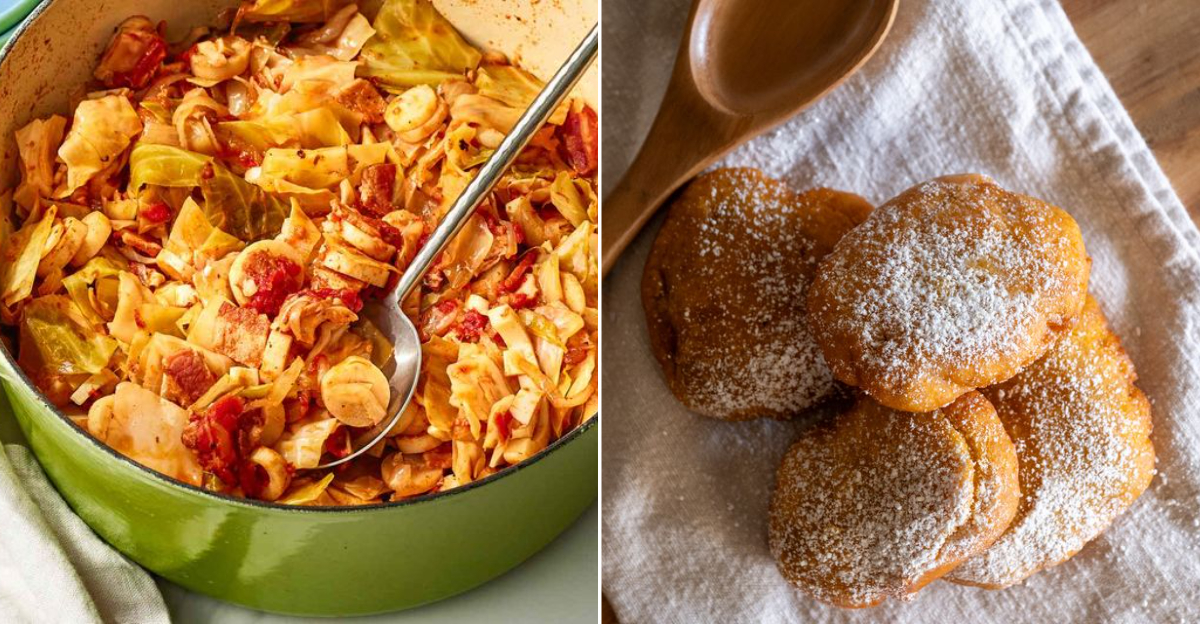12 Deliciously Unexpected Foods You’ve Probably Never Tried In Florida

Florida’s culinary scene goes way beyond the expected oranges and key lime pie.
As a food explorer who’s lived in the Sunshine State for over a decade, I’ve discovered some truly unique eats hiding in plain sight.
From swamp delicacies to ethnic fusion creations, Florida’s food landscape is as diverse as its population.
Ready for a tasty adventure through some of Florida’s most surprising bites?
1. Gator Tail: Not Just For Show
The first time I tried gator tail at a roadside shack near the Everglades, I was convinced it would taste like fishy chicken. Boy, was I wrong! This Florida delicacy has a unique texture that falls somewhere between chicken and pork, with a mild flavor that soaks up seasonings beautifully.
Most places serve it fried in bite-sized nuggets with a crispy coating that gives way to tender meat inside. The locals typically dunk it in remoulade or a spicy sauce that complements rather than masks the flavor.
During gator season, you’ll find the freshest cuts at authentic Florida restaurants, particularly in central and south Florida. Don’t worry—it’s farm-raised and sustainably harvested, making it an eco-friendly protein option with a story worth telling!
2. Boiled Peanuts: The Roadside Revelation
“You’ve never had boiled peanuts?” My neighbor looked shocked when I confessed this gap in my culinary education. Now I’m the one who can’t believe there are folks who haven’t experienced this quintessential Florida snack!
Green peanuts simmered for hours in salty brine create something entirely different from their roasted cousins. The soft, bean-like texture might surprise first-timers, but the savory, sometimes spicy flavor is instantly addictive.
I’ve found the best ones come from weather-beaten roadside stands along rural highways, particularly in North Florida. Look for hand-painted signs and vendors who cook them in massive pots right there. The Cajun-spiced variety adds a kick that pairs perfectly with an ice-cold sweet tea on a hot Florida afternoon.
3. Swamp Cabbage: Florida’s Hidden Heart
Harvested from the core of the sabal palm (Florida’s state tree!), swamp cabbage was my unexpected favorite at a backyard cookout in LaBelle. The name doesn’t do justice to this tender, versatile delicacy that native Floridians have enjoyed for generations.
Also called heart of palm, it’s typically slow-cooked with bacon and seasonings until it develops a buttery, artichoke-like flavor. The texture remains slightly crunchy, offering a satisfying bite that pairs wonderfully with smoked meats.
Your best bet is small-town festivals in places like Okeechobee or family-owned restaurants that maintain connections with local harvesters who practice sustainable collection methods.
4. Conch Fritters: Crunchy Keys Classic
My first Key West vacation introduced me to these golden-fried treasures that locals pronounce “konk.” These crispy, hush puppy-like balls contain tender bits of conch meat mixed into a savory batter with bell peppers, onions, and secret spice blends guarded like pirate treasure.
The contrast between the crunchy exterior and the soft, flavorful interior creates a textural wonderland. Most places serve them with a pink or spicy dipping sauce that elevates the experience to new heights.
While technically imported from the Bahamas, conch fritters have become a Florida Keys staple. For the most authentic version, skip the tourist traps and head to local dives where fishermen eat. Just remember that conch is now sustainably farmed to protect wild populations—another reason to feel good about this delicious indulgence!
5. Smoked Mullet Dip: Florida’s Coastal Treasure
“Just try it,” urged my fishing guide in Cedar Key, pushing a container of what looked like tuna salad across the table. That first taste of smoked mullet dip changed my relationship with Florida seafood forever!
This Gulf Coast specialty transforms humble mullet—a fish once considered only suitable for bait—into a smoky, creamy spread that outshines fancy imported pâtés. The smoking process infuses the fish with depth while eliminating any fishiness, and when mixed with mayo, cream cheese, and spices, it becomes utterly addictive.
You’ll find the best versions at fish markets and unpretentious seafood shacks along Florida’s west coast from Apalachicola to Naples. Locals eat it with saltine crackers, but I prefer it piled on a slice of Cuban bread with sliced tomatoes and a cold beer.
6. Datil Pepper Sauce: St. Augustine’s Fiery Secret
Walking through St. Augustine’s historic district, I spotted locals adding drops from unmarked bottles to everything from oysters to scrambled eggs. My curiosity led me to datil pepper sauce—quite possibly Florida’s most underrated culinary contribution!
These small, fiery peppers grow primarily around St. Augustine, brought by Minorcan settlers centuries ago. Unlike commercial hot sauces, datil sauce balances serious heat with a distinctive fruity sweetness that doesn’t overwhelm food.
Every St. Augustine family seems to have their secret recipe, ranging from vinegar-based versions to sweet-hot jellies. Most contain a careful blend of datils, vinegar, fruits, and spices. The best way to experience this local treasure is at St. Augustine restaurants or farmers markets where small-batch producers sell their liquid gold—just remember that a little goes a long way!
7. Kumquat Preserves: Tiny Citrus, Huge Flavor
Passing through the tiny town of Dade City during their annual Kumquat Festival completely changed my understanding of these bite-sized citrus fruits. Unlike their larger cousins, kumquats are eaten whole—skin and all—creating a sweet-tart flavor explosion that’s uniquely addictive.
Local artisans transform these tiny treasures into preserves that capture Florida sunshine in a jar. The marmalade-like spread balances the sweet rind with the tart interior, creating something that elevates everything from morning toast to glazed pork.
Florida’s kumquat capital lies in Pasco County, where small groves produce the bulk of the nation’s crop. Visit during January’s harvest season for the freshest preserves, or look for them at specialty food shops throughout Central Florida. My personal favorite use? Spooning it over vanilla ice cream for a dessert that perfectly captures Florida’s sweet-tart personality.
8. Camel Rider Sandwich: Jacksonville’s Multicultural Marvel
“Want a Camel Rider?” asked my Jacksonville colleague during lunch break. I thought it was a joke until she handed me what would become my favorite Florida sandwich discovery!
This uniquely Jacksonville creation emerged from the city’s Arab-American community. It features seasoned cold cuts, lettuce, tomato, and Italian dressing stuffed into a pocket of fresh pita bread. The magic happens when the dressing soaks slightly into the bread, creating a perfect harmony of flavors and textures.
Unlike the Cuban sandwich that gets all the Florida fame, the Camel Rider remains a local secret, found primarily in Jacksonville’s deli-convenience stores called “The Beaches.” The best versions come from family-owned spots that have been making them the same way for decades. It’s a perfect example of how immigrant cultures have quietly shaped Florida’s food landscape into something uniquely delicious.
9. Deviled Crab Croquettes: Tampa’s Cuban-Crustacean Fusion
While exploring Tampa’s historic Ybor City, I noticed locals lining up for what looked like football-shaped empanadas. “Deviled crabs,” explained the man behind me, “Tampa’s best-kept secret.” He wasn’t exaggerating!
These croquettes blend Cuban and Spanish influences with Florida’s abundant blue crab. The filling combines delicate crabmeat with a sofrito of peppers, onions, and spices, all bound with bread crumbs and fried to golden perfection. The result is crispy outside, tender inside, with a subtle heat that complements rather than overwhelms the sweet crab.
Originally created by cigar factory workers as affordable lunches, authentic deviled crabs are increasingly rare treasures. Look for them in Tampa’s historic neighborhoods or at old-school seafood markets. The best ones use minimal filler and come with a wedge of lemon—simple perfection that connects you to generations of Tampa food tradition.
10. Roselle Tea: Florida’s Crimson Refreshment
I first encountered roselle at a farmers market in Homestead, where a vendor was selling deep red drinks that looked like cranberry juice. “Florida cranberry,” she called it, though it’s actually a type of hibiscus that thrives in South Florida’s tropical climate.
The fleshy calyxes of the roselle plant brew into a vibrantly crimson tea with a tart, berry-like flavor that’s naturally refreshing. Many Caribbean and Latin American communities in Florida grow roselle in backyard gardens, using it for everything from cooling drinks to jellies.
Finding roselle products requires venturing beyond supermarkets to farmers markets or Caribbean grocery stores, particularly in Miami-Dade County. During holiday seasons, look for sorrel drinks (the Caribbean name for roselle) at cultural festivals. The health benefits—rich in antioxidants and vitamin C—are just a bonus to this deliciously tart Florida treat!
11. Maraca Pie: Seminole Pumpkin Perfection
During a cultural heritage festival near the Big Cypress Reservation, an elder offered me a slice of what looked like pumpkin pie. “Maraca pie,” she corrected me, introducing me to one of Florida’s truly indigenous foods.
Made from the Seminole pumpkin (resembling a maracas instrument when dried), this dessert predates Key lime pie by centuries. The small, sweet pumpkins grow wild throughout Florida and were a staple for Native Americans and early settlers. The pie filling has a more complex, less stringy texture than commercial pumpkins, with notes of butterscotch and sweet potato.
Finding authentic maraca pie requires connections to Seminole communities or farmers growing heirloom varieties. Some heritage-focused restaurants occasionally feature it during fall harvest. The experience connects you to Florida’s pre-tourism food traditions and offers a delicious alternative to mass-produced pumpkin desserts.
12. Key West Pink Shrimp: The Sweet Jewels Of Florida Waters
My first taste of Key West pink shrimp came straight off a fishing boat in Stock Island. “Close your eyes,” instructed the captain as he handed me a freshly boiled specimen. The sweetness that burst across my palate wasn’t what I expected from seafood!
These coral-hued crustaceans are prized by chefs nationwide for their naturally sweet flavor and firm texture. Unlike imported varieties, these wild-caught treasures need minimal seasoning—just a squeeze of lemon and maybe a touch of butter to create seafood perfection.
While available throughout Florida, the truly transcendent experience requires visiting the Keys during shrimp season (December through June). Look for them at dockside markets or restaurants that specifically advertise “Key West pinks” on their menus. The premium price reflects their status as the ocean’s candy—once you’ve tasted them, regular shrimp will forever seem like mere imitations.
